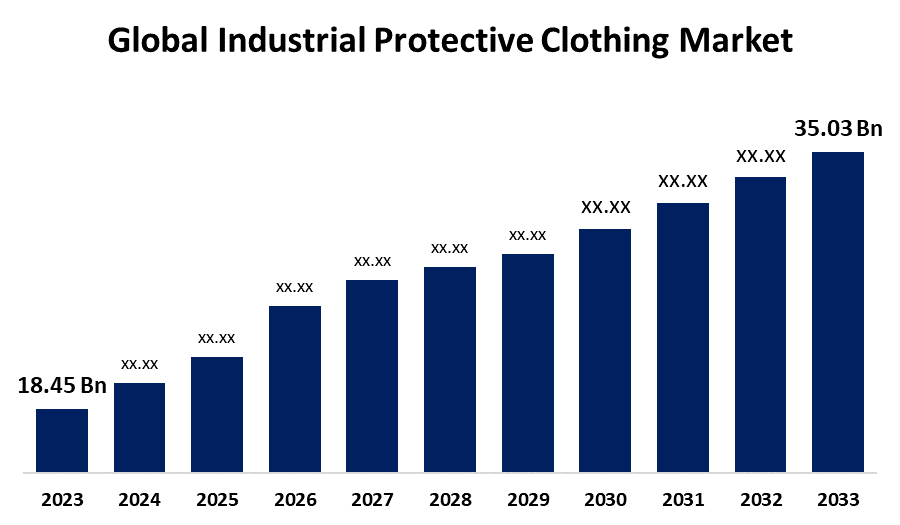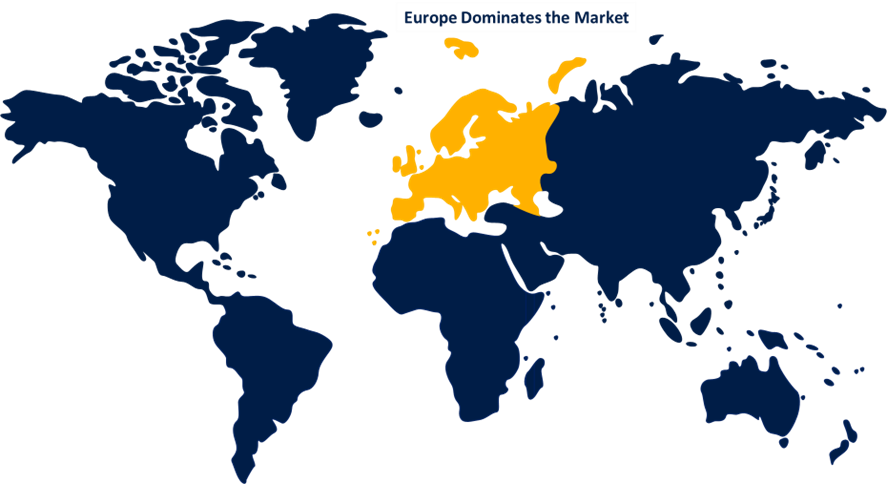Global Industrial Protective Clothing Market Size, Share and Trends Analysis, By Product (Heat & Flame Protection, Chemical Defending, Clean Room Clothing, Mechanical Protective Clothing), By Material Type (Aramid & Blends, Polyolefin & Blends, Polyamide, and PBI), By End-Use (Pharmaceuticals, Oil & Gas, Chemical, Firefighters, and Others), and By Region (North America, Europe, Asia-Pacific, Latin America, Middle East, and Africa), Analysis and Forecast 2023 - 2033
Industry: Chemicals & MaterialsGlobal Industrial Protective Clothing Market Insights Forecasts to 2033
- The Global Industrial Protective Clothing Market Size was Valued at USD 18.45 Billion in 2023
- The Market Size is Growing at a CAGR of 6.62% from 2023 to 2033
- The Worldwide Industrial Protective Clothing Market Size is Expected to Reach USD 35.03 Billion by 2033
- Asia Pacific is Expected to Grow at the fastest CAGR during the forecast period.

Get more details on this report -
The Global Industrial Protective Clothing Market Size is Anticipated to Exceed USD 35.03 Billion by 2033, Growing at a CAGR of 6.62% from 2023 to 2033.
Market Overview
Industrial protective clothing is a type of clothing designed specifically to protect workers in the industry from various hazards such as heat, chemicals, and other pathogens. These clothing items are made from materials such as aramid, polyolefin, laminated polyesters, and others. The market is projected to grow as a result of growing awareness of how important it is to prevent fatal work-related accidents. To reduce the risk of infection, governments everywhere have mandated the use of industrial protective gear. Healthcare workers' preference for industrial protective clothing to protect their health is a result of the COVID-19 pandemic, which is driving demand for it. The demand for industrial protective clothing to shield workers from workplace dangers is predicted to rise in response to an increase in shale gas production in the United States and an increase in onshore and offshore drilling operations. There is a variety of protective clothing available for specific hazards. For example, body and skin protection includes lab coats, vests, coveralls, aprons, full-body suits, surgical gowns, and aprons. The market for protective clothing is anticipated to be driven in recent years by the growing healthcare, chemical, construction, food processing, or manufacturing industries, as well as by the high rate of fatalities and unintentional injuries. Therefore, during the course of the forecast period, these factors are anticipated to accelerate market growth.
Report Coverage
This research report categorizes the industrial protective clothing market based on various segments and regions forecasts revenue growth and analyzes trends in each submarket. The report analyses the key growth drivers, opportunities, and challenges influencing the industrial protective clothing market. Recent market developments and competitive strategies such as expansion, type launch, development, partnership, merger, and acquisition have been included to draw the competitive landscape in the market. The report strategically identifies and profiles the key market players and analyses their core competencies in each sub-segment of the industrial protective clothing market.
Global Industrial Protective Clothing Market Report Coverage
| Report Coverage | Details |
|---|---|
| Base Year: | 2023 |
| Market Size in 2023: | USD 18.45 Billion |
| Forecast Period: | 2023-2033 |
| Forecast Period CAGR 2023-2033 : | 6.62% |
| 2033 Value Projection: | USD 35.03 Billion |
| Historical Data for: | 2019-2022 |
| No. of Pages: | 224 |
| Tables, Charts & Figures: | 100 |
| Segments covered: | By Product, By Material Type, By End-Use, By End-Use, By Region |
| Companies covered:: | W. L. Gore & Associates, Inc., Honeywell International Inc, Lakeland Industries, Inc., PBI Performance Products, Inc., Kimberly-Clark, Benette Safety wear, Ansell Ltd, TEIJIN LIMITED, Australian Defense Apparel, Workwear Outfitters, LLC, DuPont, TenCate Protective., Alsico, Miliken & Company, Troop Comforts Limited, Kermel, and Others. |
| Pitfalls & Challenges: | Covid-19 Empact, Challenges, Growth, Analysis. |
Get more details on this report -
Driving Factors
Protective clothing is becoming more and more necessary as public awareness of the need to lower workplace fatalities and industrial accidents rises, along with workers' growing concerns about safety in the manufacturing, oil and gas, construction, and chemical industries. Strict labor laws have an impact on the market, regulating bodies, the growth in the working population as a result of the manufacturing sector's rapid expansion, and other variables. The market for industrial protective clothing is also positively impacted by urbanization, industrialization, and the growth of infrastructure in emerging economies. An increase in workplace accidents, fatalities, and injuries, stricter government regulations, and a sufficient supply of protective apparel are the primary factors propelling the global market expansion for industrial protective clothing.
Restraining Factor
The manufacturing cost of protective clothing is high owing to the use of high performing fabrics as well as multiple testing phases, which increase the cost of protective clothing. One of the main issues preventing the protective clothing market from growing is its high cost.
Market Segmentation
The industrial protective clothing market share is classified into product, material type, and end-use.
- The chemical defending segment is estimated to hold the largest market share through the projected period.
Based on the product, the global industrial protective clothing market is classified into heat & flame protection, chemical defending, clean room clothing, mechanical protective clothing. Among these, the chemical defending segment is estimated to hold the largest market share through the projected period. Industrial protective apparel demand is anticipated to rise during the forecast period due to a growing need for durable gear that will enable continuous work.
- The aramid & blends segment is estimated to hold the largest market share through the projected period.
Based on the material type, the global industrial protective clothing is classified into aramid & blends, polyolefin & blends, polyamide, and PBI. Among these, the aramid & blends segment is estimated to hold the largest market share through the projected period. Owing to its superior heat and chemical resistance, longevity, and flame-retardant qualities, Aramid & Blends is one of the most widely used materials for protective clothes.
- The chemical segment is estimated to hold the largest market share through the projected period.
Based on the end-use, the global industrial protective clothing market is classified into pharmaceuticals, oil & gas, chemical, firefighters, and others. Among these, the chemical segment is estimated to hold the largest market share through the projected period. The segmental growth can be attributed due to the purpose of chemical protective apparel is to shield wearers from a variety of chemical agents. High-performance clothing that protects workers with various hazardous chemicals, like paints, degreasers, and cleaning agents, is required by the chemical industry.
Regional Segment Analysis of the Industrial Protective Clothing Market
- North America (U.S., Canada, Mexico)
- Europe (Germany, France, U.K., Italy, Spain, Rest of Europe)
- Asia-Pacific (China, Japan, India, Rest of APAC)
- South America (Brazil and the Rest of South America)
- The Middle East and Africa (UAE, South Africa, Rest of MEA)
Europe is anticipated to hold the largest share of the industrial protective clothing market over the predicted timeframe.

Get more details on this report -
Europe is anticipated to hold the largest share of the industrial protective clothing market over the predicted timeframe. It is anticipated that the use of protective clothing in both new construction and renovation tasks will increase as a result of the low mortgage rates that have increased construction activity in Europe. The market in the area is also anticipated to be driven by demographic factors, such as variations in economic activity and income distribution.
Asia Pacific is expected to grow at the fastest CAGR growth of the industrial protective clothing market during the forecast period. The Asia Pacific region's market is expected to grow at a faster rate than the rest due to a number of factors, including an increase in occupational fatalities, the necessity of durable mechanical wear resistance, the need for high-utility industrial protective clothing in most core industries like oil and gas, metal manufacturing, and automotive, and the growing importance of these requirements.
Competitive Analysis:
The report offers the appropriate analysis of the key organizations/companies involved within the industrial protective clothing market along with a comparative evaluation primarily based on their type of offering, business overviews, geographic presence, enterprise strategies, segment market share, and SWOT analysis. The report also provides an elaborative analysis focusing on the current news and developments of the companies, which includes type development, innovations, joint ventures, partnerships, mergers & acquisitions, strategic alliances, and others. This allows for the evaluation of the overall competition within the market.
List of Key Companies
- W. L. Gore & Associates, Inc.
- Honeywell International Inc
- Lakeland Industries, Inc.
- PBI Performance Products, Inc.
- Kimberly-Clark
- Benette Safety wear
- Ansell Ltd
- TEIJIN LIMITED
- Australian Defense Apparel
- Workwear Outfitters, LLC
- DuPont
- TenCate Protective.
- Alsico
- Miliken & Company
- Troop Comforts Limited
- Kermel
- Others
Key Target Audience
- Market Players
- Investors
- End-users
- Government Authorities
- Consulting And Research Firm
- Venture capitalists
- Value-Added Resellers (VARs)
Recent Developments
- In April 2023, Tencate Protective Fabrics introduced Tecasafe360+, an inherent FR fabric integrated with the XLANCE stretch technology, offering stretch with remarkable recovery. It keeps its shape through multiple washings and uses without sagging or bagging. With its superior shape recovery, Tecasafe360+ aims to keep workers safe by offering a perfect fit that doesn't sag.
- In May 2023, DuPont released a statement announcing that it has entered into an agreement for the acquisition of Spectrum Plastics Group from AEA Investors, which was completed in August. The partnership is in an ideal position to continue providing cutting-edge solutions for critical healthcare applications and strong customer service.
Market Segment
This study forecasts revenue at global, regional, and country levels from 2023 to 2033. Spherical Insights has segmented the industrial protective clothing market based on the below-mentioned segments:
Global Industrial Protective Clothing Market, By Product
- Heat & Flame Protection
- Chemical Defending
- Clean Room Clothing
- Mechanical Protective Clothing
Global Industrial Protective Clothing Market, By Material Type
- Aramid & Blends
- Polyolefin & Blends
- Polyamide
- PBI
Global Industrial Protective Clothing Market, By End-Use
- Pharmaceuticals
- Oil & Gas
- Chemical
- Firefighters
- Others
Global Industrial Protective Clothing Market, By Regional Analysis
- North America
- US
- Canada
- Mexico
- Europe
- Germany
- UK
- France
- Italy
- Spain
- Russia
- Rest of Europe
- Asia Pacific
- China
- Japan
- India
- South Korea
- Australia
- Rest of Asia Pacific
- South America
- Brazil
- Argentina
- Rest of South America
- Middle East & Africa
- UAE
- Saudi Arabia
- Qatar
- South Africa
- Rest of the Middle East & Africa
Need help to buy this report?